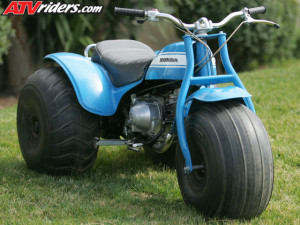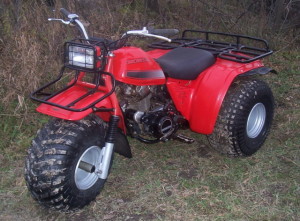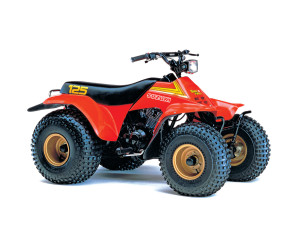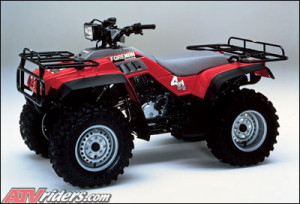When I hear the word ATV, short for all terrain vehicle, I automatically think four wheeler because those are the ATVs I grew up with and are the most common incarnation of the ATV. However, ATVs were originally invented as three wheelers, with the first ATV from a major manufacturer, Honda, shown below.

This is the ATC90 (All terrain cylinder 90), released originally by Honda in 1970. It was designed with large soft tires to make up for its lack of suspension. The ATV was made popular by its appearances in various movies and TV shows.
Slowly over the years the aesthetics of the ATV evolved, becoming marginally sleeker with knobbier tires and lights. Show below is a 1977 ATC90 model by Honda. It still had no suspension.

Eventually people began to realize that the ATVs could be used for more than just getting around and having fun; they could be used for work. At this point the racks that are now a mainstay on ATVs were born, seen below in this 1982 Honda ATC200 Big Red. By this point in their development the old ball like tires had been left behind and suspension was introduced for the first time.

It was around this time that the first four wheel ATV was produced. It was produced by Suzuki and was reminiscent of the first four wheeler in its simple design. The model was called the 1982 QuadRunner LT125 and can be seen below. It included modern innovations such as suspension but no racks

By 1987 the four wheeler industry had caught up with the three wheelers in being used for work, with racks being added and looks refined. This was seen for the first time in 1987 with the Honda foreman 4×4, seen below.

From this point on the evolution of the aesthetics of the ATV was defined by it becoming more powerful, more capable, and sleeker every year leading to the current incarnation. Shown below is a 2016 Suzuki KingQuad 4×4.

Sources:
http://cars-pics-db.com/photo/honda-atc-90/05/default.html
http://www.armslist.com/posts/717290/evansville-indiana-vehicles-for-sale-trade–1977-honda-atc-90
http://www.venustel.com/~muddogs/restore.htm
http://utvactionmag.com/features/suzuki-atvs-that-changed-the-world
http://pictures.dealer.com/m/motosthibaultcapdelamadeleinetc/0408/2916ffde6f75edf5954ed301fb690dc8x.jpg

18 Comments. Leave new
This post’s emphasis on the influence of aesthetics on ATV culture is fantastic. The design features mentioned, which range from striking color schemes to clean lines, significantly alter the riding experience. Excellent information about how ATV customization can be used to show own style.
While I initially associate the term with four-wheelers, it’s intriguing to learn about their origins as three-wheelers from Honda. The ongoing evolution in power, capability, and design truly showcases the ATV’s journey and its growing appeal in the off-road community. Excited to see what the future holds for these amazing machines
When I hear the word ATV, short for all-terrain vehicle, I automatically think of four-wheelers because those are the ATVs I grew up with and are the most common incarnation of the ATV. However, it’s fascinating to learn that ATVs were originally invented as three-wheelers. The first ATV from a major manufacturer, Honda, truly paved the way for the versatile four-wheelers we know today. It’s incredible to see how the design and functionality have evolved over the years
As I have overviewed both vintage and modern ATVs,
I am excited to see the evolution from the classic Honda ATC90 to the advanced four-wheelers of today. It’s remarkable to witness how design and technology have advanced, enhancing performance and style.
This blog provides a fascinating historical overview of ATV evolution, from its early three-wheeled models to modern four-wheelers. The progression highlights the technological advancements and increasing versatility of ATVs over the decades.
It’s fascinating to see how the ATV has evolved from the three-wheeled Honda ATC90 to the modern four-wheelers we know today. The advancements in suspension and design highlight the versatility and growing functionality of ATVs over the years.
Great information, thanks for sharing valuable insights!
The aesthetics of ATVs go beyond rugged functionality, combining sleek designs with bold, eye-catching colors and durable finishes. These vehicles are crafted to appeal to outdoor enthusiasts who value both performance and style. From aggressive stances to innovative lighting, ATVs showcase a blend of power and visual appeal that enhances the off-road experience.
The aesthetics of ATVs combine rugged functionality with a sleek, powerful design that appeals to outdoor enthusiasts. From aggressive tires to bold, angular frames, ATVs are built to not only perform in tough terrains but also to look fierce and dynamic, making every off-road adventure as visually thrilling as it is exhilarating.
It’s fascinating to see how ATVs evolved from three-wheelers like the Honda ATC90 to today’s powerful four-wheelers. The shift from simple designs to work-ready machines with suspension and racks truly transformed the industry!
The evolution of ATVs from three-wheelers like the Honda ATC90 to today’s powerful four-wheelers like the 2016 Suzuki KingQuad 4×4 shows how these vehicles have advanced in both utility and design. Fascinating history!
It’s fascinating to see how ATVs have evolved from the original three-wheelers like the Honda ATC90 to the powerful, versatile four-wheelers we know today. The blend of innovation and practicality over the years is remarkable!
Fantastic article! It’s fascinating to see how ATV aesthetics can transform a standard ride into a personalized masterpiece. The examples provided show just how important visual appeal is to enthusiasts and how it adds to the excitement of off-roading. Well done.
I love how this post highlights the impact of aesthetics on ATV culture. From bold color choices to sleek lines, the design elements discussed make a significant difference in the riding experience. Great insights into how personal style can be expressed through ATV customization.
The Honda ATC90, introduced in 1970, was an early all-terrain vehicle featuring large tires and no suspension. By 1977, its design had evolved with sleeker aesthetics and knobbier tires, yet it still lacked suspension. This model highlights the early innovations in ATV
design and the gradual development of off-road technology.
The Honda ATC90, introduced in 1970, evolved in design by 1977 but still lacked suspension, highlighting early ATV innovation
.
This blog perfectly captures how aesthetics play a crucial role in ATV design. The attention to detail in color schemes and custom graphics truly enhances the overall appeal and individuality of these machines. Thanks for showcasing how style and performance go hand-in-hand!
It is interesting to see how ATV changes through the years. In my opinion, the design of the outlook of ATV becomes more and more aggressive, which give people the feeling of strength.